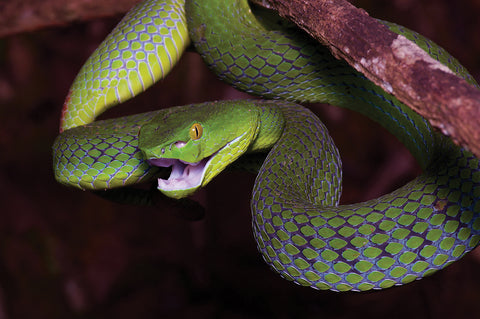
Human Enemies Weren’t the Only Thing That Were Lethal to U.S. Troops in Vietnam
When we think about war, it is tempting to focus only on its human participants. Sometimes it is all too easy to forget that the natural world around us is, in fact, alive and dynamic, and filled with creatures that can have unpredictable and dangerous interactions with humans. Soldiers often run across these creatures when fighting in harsh or remote environments—indeed these creatures often literally run, or crawl, across them. Wildlife in war zones can be fascinating, annoying, or even fatal. Animals and insects remind us that, despite incredible advances in technology and weaponry, there are still some things that humans cannot fully control. The Vietnam War is a particularly good example of this—a war in which a “Spooky” gunship could wipe out enemy troops in wreaths of fiery destruction, yet something as tiny and fragile as a single mosquito could bring death by transmitting malaria. Numerous men who fought in Vietnam mention their interactions with wildlife—good, bad, or ugly. Many of these creatures are common across Southeast Asia, and there are too many to describe in a single article. In this portfolio, we take a look at animals and insects that posed dangers to soldiers in Vietnam. In some cases, the danger seems obvious; in others, not so much. It is worth noting that the enemy often used venomous creatures against American and allied troops when possible. The VC made use of snakes, spiders, and scorpions to guard entrances to underground tunnel systems; “guard” snakes were suspended from tunnel ceilings to strike intruders, while spiders and scorpions were released from baskets to sting interlopers entering passageways [ read more at:www.historynet.com/tunnel-rats- vietnam ]. Sometimes soldiers had to get creative to keep unwelcome creatures away from them. There is no question that the presence of dangerous wildlife made fighting the Vietnam War even tougher.
The king cobra, the world’s longest venomous
snake, can grow up to about 19 feet and when threatened can raise itself
upright to about one third of its full length, which can make it as tall as a
person. The king cobra growls, has sharp eyesight and potent venom, and
prefers to eat other snakes.
The bamboo
viper is another type of pit viper found in Vietnam. Pit vipers’ speed,
toxicity, and preference for hunting at night make them formidable reptiles.
Rattlesnakes and pythons share the same type of “thermal vision” as pit
vipers.
this article first appeared in vietnam magazine
Tigers were once
widespread in Vietnam; these “big cats” hunt alone and prey on large mammals
such as deer. Sadly, recent reports indicate that tigers have possibly gone
extinct from both Vietnam and Laos due to hunting.
The Vietnamese funnel web
spider is one of many arachnids that inhabit wooded areas of Vietnam. Despite
their delicate appearance, funnel web spiders can deliver fatal bites and
their fangs are often sharp enough to penetrate clothing and shoes.
The Vietnamese tiger tarantula is a large and
highly aggressive spider that lives in muddy undergrowth, often around rice
paddies. It packs a powerful bite and, unlike other tarantulas, tends to be
confrontational.
Rats are common in
Vietnam and “overran” firebases. Rats carry and spread diseases aside from
being pesky scavengers.
Most of the time bats do not bother people.
However, bats do carry rabies and other diseases. This friendly looking fruit
bat of a species called Lyle’s flying fox is a potential carrier of the deadly
Nipah virus.
Red ants are commonly described by Vietnam veterans
as having been a hazard in the bush. Vietnamese fire ants live in rotting logs
and deliver painful bites, often in swarms. Some veterans have reported being
bitten by “blood-sucking” ants that preyed on them when they were wounded.
In terms of
bloodsucking pests, nothing quite compares to the leech. It is one of the most
hated creatures associated with the Vietnam War. No body part was safe from
these aquatic predators, which often had to be burned off.
While often made into pets, monkeys can carry rabies,
making their bite dangerous.
The mosquito
was probably the most dangerous creature faced by troops in the Vietnam War
because its bite could carry malaria.
The Vietnamese giant
forest scorpion can grow up to 12 inches long. It is an aggressive species
known to kill its own kind, with a painful sting and paralytic venom.
This story appeared in the 2023 Autumn issue of Vietnam magazine.
historynet magazines
Our 9 best-selling history titles feature in-depth storytelling and iconic imagery to engage and inform on the people, the wars, and the events that shaped America and the world.
